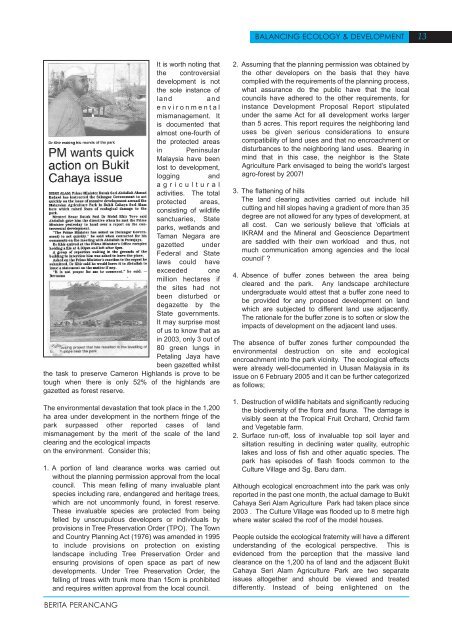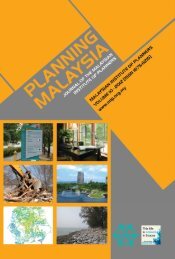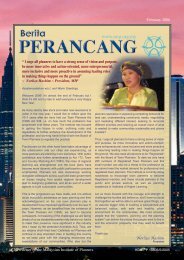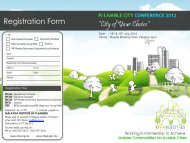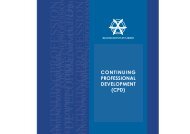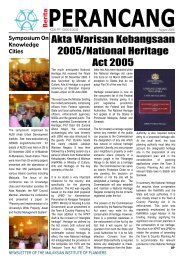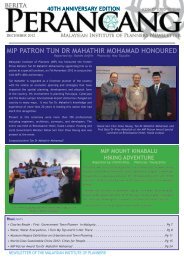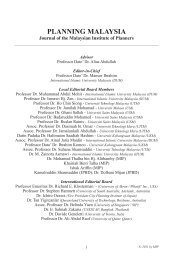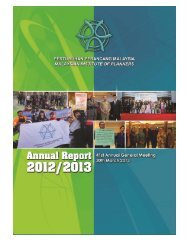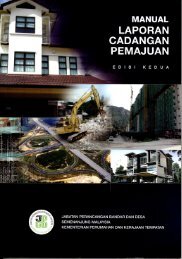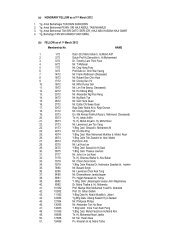Download November 2005 Issue - Malaysian Institute of Planners
Download November 2005 Issue - Malaysian Institute of Planners
Download November 2005 Issue - Malaysian Institute of Planners
Create successful ePaper yourself
Turn your PDF publications into a flip-book with our unique Google optimized e-Paper software.
BALANCING ECOLOGY & DEVELOPMENT 13It is worth noting thatthe controversialdevelopment is notthe sole instance <strong>of</strong>landandenvironmentalmismanagement. Itis documented thatalmost one-fourth <strong>of</strong>the protected areasin PeninsularMalaysia have beenlost to development,logging andagriculturalactivities. The totalprotected areas,consisting <strong>of</strong> wildlifesanctuaries, Stateparks, wetlands andTaman Negara aregazetted underFederal and Statelaws could haveexceeded onemillion hectares ifthe sites had notbeen disturbed ordegazette by theState governments.It may surprise most<strong>of</strong> us to know that asin 2003, only 3 out <strong>of</strong>80 green lungs inPetaling Jaya havebeen gazetted whilstthe task to preserve Cameron Highlands is prove to betough when there is only 52% <strong>of</strong> the highlands aregazetted as forest reserve.The environmental devastation that took place in the 1,200ha area under development in the northern fringe <strong>of</strong> thepark surpassed other reported cases <strong>of</strong> landmismanagement by the merit <strong>of</strong> the scale <strong>of</strong> the landclearing and the ecological impactson the environment. Consider this;1. A portion <strong>of</strong> land clearance works was carried outwithout the planning permission approval from the localcouncil. This mean felling <strong>of</strong> many invaluable plantspecies including rare, endangered and heritage trees,which are not uncommonly found, in forest reserve.These invaluable species are protected from beingfelled by unscrupulous developers or individuals byprovisions in Tree Preservation Order (TPO). The Townand Country Planning Act (1976) was amended in 1995to include provisions on protection on existinglandscape including Tree Preservation Order andensuring provisions <strong>of</strong> open space as part <strong>of</strong> newdevelopments. Under Tree Preservation Order, thefelling <strong>of</strong> trees with trunk more than 15cm is prohibitedand requires written approval from the local council.2. Assuming that the planning permission was obtained bythe other developers on the basis that they havecomplied with the requirements <strong>of</strong> the planning process,what assurance do the public have that the localcouncils have adhered to the other requirements, forinstance Development Proposal Report stipulatedunder the same Act for all development works largerthan 5 acres. This report requires the neighboring landuses be given serious considerations to ensurecompatibility <strong>of</strong> land uses and that no encroachment ordisturbances to the neighboring land uses. Bearing inmind that in this case, the neighbor is the StateAgriculture Park envisaged to being the world’s largestagro-forest by 2007!3. The flattening <strong>of</strong> hillsThe land clearing activities carried out include hillcutting and hill slopes having a gradient <strong>of</strong> more than 35degree are not allowed for any types <strong>of</strong> development, atall cost. Can we seriously believe that ‘<strong>of</strong>ficials atIKRAM and the Mineral and Geoscience Departmentare saddled with their own workload and thus, notmuch communication among agencies and the localcouncil’ ?4. Absence <strong>of</strong> buffer zones between the area beingcleared and the park. Any landscape architectureundergraduate would attest that a buffer zone need tobe provided for any proposed development on landwhich are subjected to different land use adjacently.The rationale for the buffer zone is to s<strong>of</strong>ten or slow theimpacts <strong>of</strong> development on the adjacent land uses.The absence <strong>of</strong> buffer zones further compounded theenvironmental destruction on site and ecologicalencroachment into the park vicinity. The ecological effectswere already well-documented in Utusan Malaysia in itsissue on 6 February <strong>2005</strong> and it can be further categorizedas follows;1. Destruction <strong>of</strong> wildlife habitats and significantly reducingthe biodiversity <strong>of</strong> the flora and fauna. The damage isvisibly seen at the Tropical Fruit Orchard, Orchid farmand Vegetable farm.2. Surface run-<strong>of</strong>f, loss <strong>of</strong> invaluable top soil layer andsiltation resulting in declining water quality, eutrophiclakes and loss <strong>of</strong> fish and other aquatic species. Thepark has episodes <strong>of</strong> flash floods common to theCulture Village and Sg. Baru dam.Although ecological encroachment into the park was onlyreported in the past one month, the actual damage to BukitCahaya Seri Alam Agriculture Park had taken place since2003 . The Culture Village was flooded up to 8 metre highwhere water scaled the ro<strong>of</strong> <strong>of</strong> the model houses.People outside the ecological fraternity will have a differentunderstanding <strong>of</strong> the ecological perspective. This isevidenced from the perception that the massive landclearance on the 1,200 ha <strong>of</strong> land and the adjacent BukitCahaya Seri Alam Agriculture Park are two separateissues altogether and should be viewed and treateddifferently. Instead <strong>of</strong> being enlightened on theBERITA PERANCANG


